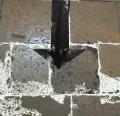Jean-Paul CHAPON Galeriste
Au premier regard la peinture de Jame Saurel paraît difficile à saisir. On a l’impression d’une œuvre qui elle-même ne voudrait pas se laisser appréhender. L’économie dans la forme du trait, le faible nombre de couleurs utilisées, souvent les mêmes, la rigueur de la construction peuvent faire paraître abstraite -au sens premier du terme- voir abrupte l’œuvre qui nous est proposée. Sur certaines toiles, on découvre des plans où le véhicule pictural prend des aspects de rugosité volontaire qui ajoute à ce premier sentiment. Comme si l’artiste ne se livrait qu’avec parcimonie alors qu’il s’agit d’extrême pudeur et de grande intériorité.
Pas d’arrangements conviviaux sur la toile, un travail sobre, rigoureux, silencieux qui pourrait paraître au premier abord austère. Rien dans cette peinture de combinatoire ou d’opératif pour « faire du beau » ou pour séduire. Nous sommes ici dans la volonté du dire et dans le véritablement dit, tout le contraire du superficiel, de l’anecdotique, loin de la peinture événement ou happening.
Il faut savoir regarder avant de voir et le regard se fixe, s’attache, pénètre plus avant dans la toile pour en saisir tout le contenu et en faire sa fête. On sait bien qu’en certaines circonstances privilégièes le regard écoute.
Les couleurs sourdes, profondes restent toujours chaudes enchâssées dans des charpentes noires qui comme le plomb sertissant le verre à vitrail rehaussent leur luminosité.
Tous les tableaux comportent une ou plusieurs fenêtres carrées ou rectangulaires. Certaines sont occultées par la couleur de l’espace peint dans lequel elles s’inscrivent, comme muettes, vestiges d’un passé, mémoire de ce qui fut ou regret de ce qui aurait pu être. D’autres sont plus perceptibles, d’autres s’affirment omniprésentes.Cette exposition nous donne à voir les portraits de villes soit n’étant jamais nées soit mortes soit des cités à naître ou des métropoles en devenir.
Ce qui semblait relever de prime abord d’un propos pessimiste fait bonne part à l’espérance par la présence de ces ouvertures sur la toile qui laissent pénétrer la lumière. Artiste certes, Ethnologue, Géographe, Architecte, Jame Saurel est aussi tout cela en peinture. Une peinture qui à mon expérience n’a pas fini de nous procurer de belles émotions d’amateurs d’Art, de par son contenu et sa plasticité.
Et puis parce qu’en plus de médecin et de peintre il est philosophe, je terminerai en citant Bergson : « Il faut un supplément d’âme pour administrer le progrès ». L’œuvre de Jame Saurel nous y aide aussi, le progrès et la vie.
Texte du 22 Octobre 1996
In the first glance the paint(painting) of Jame Saurel seems difficult to seize. We have the impression(printing) of a work which would not want itself to be allowed arrest(dread). The economy in the shape of the line(feature), the low(weak) number of used colors, often the same, the rigor of the construction can publish abstracted - in the first sense(direction) of the term to see abrupt(steep) the work which is proposed to us. On certain paintings(clothes), we discover plans where the pictorial vehicle takes aspects of voluntary roughness which adds to this first feeling. As if the artist was engaged(surrendered) only with economy while it is about extreme modesty and of big interiority. No friendly arrangements on the painting(cloth), a sober, rigorous, silent work which could seem at first sight austere. Nothing in this paint(painting) of combinatorial or operational " to make of the beautiful " or to seduce. We are here in the will of to say and in the really said, all the opposite of the superficial, the trivial, far from. It is necessary to know how to look before seeing and the glance settles, fastens, penetrates more before into the painting(cloth) to seize all the contents with it and make its party (holiday). We know well that in certain privileged circumstances the glance listens to. The deaf, deep colors remain always warm set in black skeletons which as the lead(shot) setting the glass with stained glass heighten their luminosity.
All the paintings(boards) contain one or several square or rectangular windows. Some are hidten(darkened) by the color of the painted space which they join, as mutes, vestiges of past, memory(report) of what was or regret of what would have been able to be. Others are more perceptible, the others consider themselves omnipresent. This exhibition(exposure) gives us to see city portraits either having never been born or died or from cities(estates) to arise or from metropolises to become there. What seemed to raise(find) at first sight from a pessimistic comment made good part for the hope by the presence of these openings on the painting(cloth) which let penetrate into the light. Artist certainly, Ethnologist, Geographer, Architect, Jame Saurel is also all this in paint(painting). A paint(painting) which in my experience(experiment) did not stop getting us of beautiful feelings of art lovers, due to his(her,its) contents and his(her,its) plasticity.
And then because besides doctor and besides painter he is a philosopher, I shall end by quoting Bergson: " is needed a supplement of soul to administer the progress ". The work of Jame Saurel helps us there also, the progress and the life.
Text of October 22nd, 1996
第一眼的paint(涂层)的saurel多久出现一次卡纸似乎难以把握。 我们有这样一种印象(打印)的一个工作,不希望自己是允许逮捕(恐惧)。 在经济的线形(功能)、低(弱)的颜色,这种情况往往是一样的,严格的抽象的建筑可以发布在第一感觉(方向)的术语就会看到突然(陡坡)的工作,是向我们提出。 在一些画作(衣服),我们发现这样的计划需要方面的图片车辆的粗糙度,增加了自愿的第一感觉。 这位艺术家,如果结合(投降),只有在它是经济的谦虚和对至尊大大家做额外。
任何友好的安排绘画(布),一个严肃、严格的工作保持沉默初看上去可能紧缩。 本涂料(油漆)的组合或业务",使美丽"或诱惑。 我们都在这里,要说,会说的,所有的对面
要知道如何查找后才能见到,了然下沉,拉链,穿过更多的绘画之前(布)的内容,抓住一切配合,使其党(假期)。 我们清楚地知道,在某些特殊情况下,侦听,看一看。 聋的颜色较深,始终设置为黑色骷髅的温暖为主导(截图)设置的玻璃与玻璃提高其发光度。
所有的画(主板)包含一个或多个正方形或长方形窗户。 一些hidten(黑暗)所产生的颜色的油漆,他们加入空间,为静音,过去的残余,内存(报告)的内容,遗憾的是什么都无法得到。 有些人则较为明显,另外一些人则认为自己无所不在。
这展览会(曝光)让我们看到城市从来没有生下来都有肖像画或已死亡或从城市(h)出现,或从大城市到成为他们。 看来,提高(查找)在第一眼很大一部分评论的一个悲观的希望的存在,这一幅画上这些开口(布),让我们穿透入的光线。
艺术家当然,民俗学者、地理学家、建筑师、巿民多一些是一场谁也输不起这saurel在paint(绘画)。 一个paint(涂层),这是我的经验(实验)并未停止使用我们的美丽感情的艺术爱好者,由于其内容及其可塑性。
然后parce,除了医生和他是一个哲学家除了画家,我引证bergson:"是需要一个补充的灵魂,管理的进步”。 巿民多一些的工作也有助于我们saurel、进步和生活。
文本的10月22日,1996年
Ajouter un commentaire





